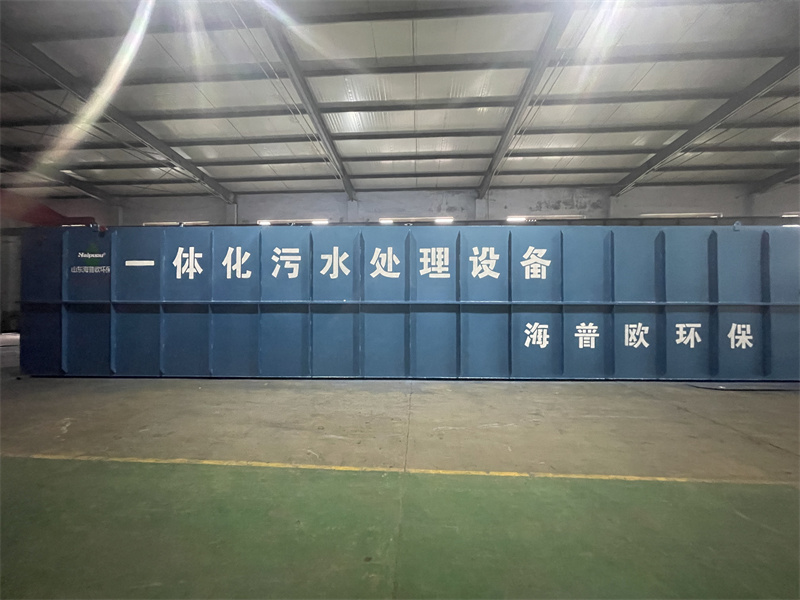News details
Integrated Sewage Treatment Equipment: An Efficient Solution and Application Guide
Release time:
2025-11-21 16:13
Against the backdrop of increasingly severe global water scarcity and environmental pollution, sewage treatment has become a crucial link in safeguarding the ecological environment. As an integrated and high-efficiency sewage treatment solution, integrated sewage treatment equipment is gradually gaining popularity across various industries. This article will delve into the core technologies, advantages, applicable scenarios, and key selection considerations of integrated sewage treatment equipment, helping you fully understand and rationally apply this advanced environmental protection equipment.
I. Definition and Working Principle of Integrated Sewage Treatment Equipment
Integrated sewage treatment equipment is a compact sewage treatment system that integrates multiple units, including pre-treatment, biochemical treatment, and advanced treatment, into a single entity. Its working principle is based on the optimization and integration of traditional sewage treatment processes. Through the synergistic effect of physical, chemical, biological, and other treatment technologies, it effectively removes pollutants such as organic matter, suspended solids, nitrogen, and phosphorus from sewage.
Typically, the equipment consists of functional units such as a grille, equalization tank, anoxic tank, aerobic tank, sedimentation tank, and disinfection tank. The sewage first passes through the grille to remove large debris, then enters the equalization tank for water quality and quantity adjustment. Next, in the anoxic and aerobic tanks, organic matter is decomposed and nitrogen/phosphorus is removed through the metabolic activities of microorganisms. After that, solid-liquid separation is achieved in the sedimentation tank, and finally, the sewage is disinfected in the disinfection tank to ensure the effluent quality meets the corresponding standards.
II. Core Technologies and Process Types of Integrated Sewage Treatment Equipment
(I) Core Technologies
- Biological Treatment Technology: As the core of integrated equipment, biological treatment technology utilizes the life activities of microorganisms to convert organic matter in sewage into harmless substances. Common methods include the activated sludge process and biofilm process. Among them, the biofilm process is widely used in integrated equipment due to its advantages such as microbial attachment and growth, as well as strong resistance to shock loads.
- Sedimentation Technology: This technology is used to separate suspended solids and sludge from sewage, ensuring the stable operation of subsequent treatment units. The application of high-efficiency sedimentation technologies such as inclined-tube sedimentation tanks and vertical flow sedimentation tanks can significantly improve sedimentation efficiency and reduce the equipment's floor space.
- Disinfection Technology: It ensures that the effluent quality meets hygiene standards. Common disinfection methods include ultraviolet (UV) disinfection, chlorine dioxide disinfection, and ozone disinfection. UV disinfection is widely used in integrated equipment due to its advantages of no secondary pollution and simple operation.

(II) Process Types
According to the water quality characteristics of the sewage to be treated and discharge standards, integrated sewage treatment equipment is mainly divided into the following process types:
- A/O Process (Anoxic-Oxic Process): Suitable for treating high-concentration organic sewage and nitrogen-containing sewage. Nitrogen is removed through denitrification in the anoxic tank, while organic matter and ammonia nitrogen are further degraded through nitrification in the aerobic tank.
- A²/O Process (Anaerobic-Anoxic-Oxic Process): An anaerobic tank is added to the A/O process, forming a combined process of anaerobic-anoxic-oxic. This process can simultaneously remove organic matter, nitrogen, and phosphorus, making it suitable for scenarios with high requirements for nitrogen and phosphorus indicators in the effluent.
- MBR Process (Membrane Bioreactor Process): Combines biological treatment with membrane separation technology. Membrane modules replace traditional sedimentation tanks, enabling efficient solid-liquid separation. It features high effluent quality and small floor space but relatively high operating costs.
- SBR Process (Sequencing Batch Reactor Process): An intermittent activated sludge process that completes processes such as water inflow, reaction, sedimentation, and drainage in a single reactor. It has the characteristics of simple structure and strong adaptability, making it suitable for small and medium-sized sewage treatment projects.
III. Main Characteristics and Advantages of Integrated Sewage Treatment Equipment
(I) Small Floor Space
By integrating multiple treatment units into one, the integrated equipment significantly reduces the floor space compared with traditional sewage treatment plants, accounting for only 1/3 to 1/5 of that required by traditional processes. It is particularly suitable for cities and enterprises with tight land resources.
(II) High Treatment Efficiency
Adopting advanced process technologies and high-efficiency equipment components, it can quickly and effectively remove pollutants from sewage, ensuring stable effluent quality that meets standards. For example, the suspended solid concentration in the effluent of the MBR process can be lower than 10mg/L, and the COD (Chemical Oxygen Demand) removal rate can reach over 90%.
(III) Easy Installation and Short Construction Period
The equipment is prefabricated in the factory, and only simple on-site installation and commissioning are required. The construction period is usually 1 to 2 months, which is much shorter than that of traditional sewage treatment plants.
(IV) High Degree of Automation
Equipped with an advanced automatic control system, it can realize automatic operation, monitoring, and fault alarm of the equipment. Operators only need to conduct regular inspections, which greatly reduces labor costs and labor intensity.
(V) Wide Application Range
It can be applied to the treatment of various types of sewage, including domestic sewage, industrial wastewater, and medical sewage. Whether it is urban residential areas, hotels, industrial parks, or mining enterprises, suitable integrated sewage treatment equipment can be found.
(VI) Low Operating Costs
Through optimized process design and equipment selection, energy consumption and chemical consumption are reduced. At the same time, the equipment has low maintenance costs and a long service life, generally ranging from 15 to 20 years.
IV. Applicable Scenarios of Integrated Sewage Treatment Equipment
(I) Urban Domestic Sewage Treatment
Suitable for the treatment of domestic sewage in areas such as urban residential communities, urban villages, and urban-rural junctions. The treated sewage can be used for green irrigation, road flushing, etc., to realize the recycling of water resources.
(II) Industrial Wastewater Treatment
For industrial wastewater generated by industries such as chemical engineering, pharmaceuticals, food processing, textiles, and printing and dyeing, integrated sewage treatment equipment can perform targeted treatment according to the water quality characteristics of the wastewater to ensure compliance with discharge standards. For example, the A/O or A²/O process can be used for treating high-concentration organic wastewater, while a chemical precipitation unit can be added for treating heavy metal-containing wastewater.
(III) Medical Sewage Treatment
Medical sewage contains a large number of harmful substances such as bacteria and viruses, which pose great risks to the environment and human health. Through processes such as disinfection, integrated sewage treatment equipment can effectively kill pathogens in the sewage, making it meet the Discharge Standard of Water Pollutants for Medical Institutions.
(IV) Rural Sewage Treatment
In rural areas, sewage discharge is small and scattered, making traditional sewage treatment methods difficult to implement. Integrated sewage treatment equipment can be flexibly arranged according to the actual conditions of rural areas, and the treated sewage can be used for agricultural irrigation, improving the rural ecological environment.
(V) Emergency Sewage Treatment
In scenarios such as sudden water pollution incidents or temporary water demand, integrated sewage treatment equipment can be quickly deployed to realize timely sewage treatment and prevent the spread of pollution.
V. Key Considerations for Selecting Integrated Sewage Treatment Equipment
(I) Clarify Treatment Requirements
Before selecting the equipment, it is necessary to clarify key information such as the source of the sewage, water quality and quantity, and discharge standards. For example, the processes and equipment parameters required for treating domestic sewage and industrial wastewater vary greatly, so the selection should be based on actual conditions.
(II) Evaluate Equipment Quality and Performance
Choose manufacturers with a good reputation and qualifications, and check indicators such as the equipment's material, process design, and treatment efficiency. You can understand the quality and performance of the equipment by conducting on-site inspections of the manufacturer's production base and reviewing equipment operation cases.
(III) Pay Attention to Energy Consumption and Operating Costs
Energy consumption and operating costs are important expenditures during the long-term use of the equipment. When selecting, compare the energy consumption indicators, chemical consumption, and maintenance costs of different equipment, and choose the one with high cost-effectiveness.
(IV) Consider the Degree of Automation
Equipment with a high degree of automation can reduce manual operation and management costs and improve operational stability. You can select a suitable automatic control system according to actual needs, such as a remote monitoring system and an intelligent alarm system.
(V) Attach Importance to After-Sales Service
Comprehensive after-sales service can ensure the long-term stable operation of the equipment. When selecting, understand the manufacturer's after-sales service policies, including installation and commissioning, technical training, and maintenance.
VI. Industry Trends and Development Prospects of Integrated Sewage Treatment Equipment
With the increasingly strict environmental protection policies and continuous innovation in sewage treatment technology, integrated sewage treatment equipment is showing the following development trends:
- Continuous Improvement of Intelligence Level: Combining advanced technologies such as the Internet of Things (IoT), big data, and artificial intelligence (AI) to realize intelligent monitoring, intelligent regulation, and intelligent operation and maintenance of the equipment, thereby improving treatment efficiency and management level.
- Prominent Trend of Resource Utilization: Greater emphasis is placed not only on the compliance of sewage discharge but also on the recovery and utilization of water resources, energy, and nutrients in sewage. For example, through sewage recycling and reuse, biogas recovery for power generation, and other methods, the circular utilization of resources is realized.
- More Flexible Modular Design: Adopting a modular design allows for flexible combination and expansion of equipment units according to different treatment needs and site conditions, improving the adaptability and practicality of the equipment.
- Widespread Application of Green and Energy-Saving Technologies: The research, development, and application of more energy-saving and environmentally friendly treatment technologies and materials reduce the energy consumption and environmental impact of the equipment, promoting the green development of the sewage treatment industry.
As an efficient, energy-saving, and environmentally friendly sewage treatment solution, integrated sewage treatment equipment plays an important role in safeguarding the ecological environment and promoting the recycling of water resources. In future development, with continuous technological progress and the expansion of application scenarios, integrated sewage treatment equipment will surely embrace broader development prospects.
Pre
Related news











